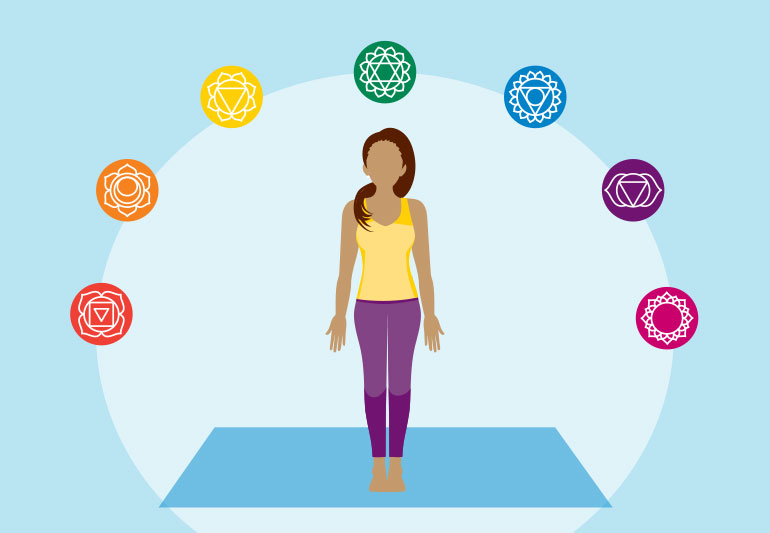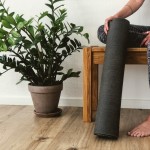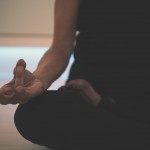Learn more about Chakras asana and how to do it on TamarSamirYoga. Read more of our yoga blogs and reviews here.
Do you fancy a little chakra journey? You learn a lot in the process - about yourself and your sensitivities, both large and small. And Petra Orzech reveals the simple means you can use to strengthen your chakras or bring them back into balance!
“Chakra” - you've heard the word before. There are t-shirts with chakra symbols or even mugs and yoga mats on which the chakras, also called chakras, are depicted, and maybe one or the other has a CD with chakra meditations. But if you ask your (mat) neighbor, you rarely get an illuminating answer to the question of what such a chakra actually is or should be. Most of the time, however, there is consensus that the word that sounds so intangible definitely has a spiritual meaning.
Right. The chakra teaching is a philosophy and meditation system originating from India, which deals with invisible energy centers. The teaching describes one of many ways in which a person can reach his goals. Since it is very clear and easy to apply to everyday life, it is now also widespread in the West - and a nice enrichment of our way of thinking.
What are chakras?
Chakras are subtle energy vortices inside and outside the body, so organically just as little present as the soul. In yoga, meditation, Reiki, TCM (traditional Chinese medicine) and AyurvedaChakras have had a permanent place for thousands of years. The knowledge about them has its origin, like all other energetic basic concepts, in the Vedic writings and the Upanishads called philosophical writings of Hinduism. It was preserved and passed on in different ways in different cultures. It is said of the Tibetans that they have the deepest knowledge of the chakras, which are only passed on orally and in the original language. In Europe, the chakra knowledge that had been handed down until then was lost with Christianization. It was only in the past centuries that Johann Wolfgang von Goethe and the founder of anthroposophy, Rudolf Steiner, revived the teaching.
Chakra - the term comes from Sanskrit and means in the literal translation wheel, disc, circle - are the connection points between the body and astral body (energy body, invisible shell) of the person. Ancient Indian and Tibetan texts mention 72,000 to 350,000 such energy centers. Seven of the chakras are considered to be the main energy centers of humans and lie along the spine or the vertical body axis. One imagines the connection points protruding several centimeters above the body surface in a funnel shape. Since chakras are not visible, their recognition and meaning took a while.
The tasks of the chakras
Put simply, chakras function like pumps with the task of absorbing energy from the outside and supplying it to the human energy system. The chakras are connected to one another along the spine, each of which is assigned to a specific area of the body. However, the chakras are designed differently depending on the person's individual development and state of consciousness. How much energy gets into the body depends on its nature. In the best case, the energy vortices rotate quickly, shine strongly, and are clear in the colors assigned to them. In Hinduism / Buddhism, one speaks of an “enlightened person” when all seven chakras are fully open and the life energy (Prana) flows without blockages and disturbances.
Each of the seven chakras also stands for a certain area of life: At every age, we learn new methods of how we can live in harmony with what we currently perceive as our environment. If we successfully go through the learning steps, our chakras are stimulated and can absorb the surrounding energy. The development of the individual energy centers should begin in the womb. Childhood up to the age of seven is considered to be the formative phase. A lack of love, indifference on the part of parents, or the suppression of natural needs can lead to a situation in which one or more chakras develop only inadequately or not at all. The first year of life is particularly important for the root chakra, responsible for basic trust. But later events or an unfavorable way of life can also lead to blockages in what are actually well-developed chakras. Feelings such as fear, envy, jealousy, or hatred can lead to under-or over-functioning, which we always find annoying and uncomfortable.
Chakra work can solve these blockages: The aim is to reach the levels of consciousness through becoming conscious. This means that learning steps are repeated until the respective learning objective is achieved. Brake blockages - if they are recognized, the resolution is no longer difficult. By empathizing with them and without judgment, accepting and accepting all associated feelings, and then letting go of them. The yoga philosophy also says that we are not powerless at the mercy of such disturbances. So one of the goals in yoga is to heal body, mind, and soul in an energetic way and to lead to wholeness. Through the body postures, breathing, and meditation - for example in the form of stretching, strength building, or concentration exercises - you influence the energy state of the chakra in question. This can be short-term or long-term,
Each of the seven large chakras vibrates in a basic color and is associated with certain organs and areas of the body. The seven chakras also correspond to the seven main glands of the endocrine system (our hormonal system) and control specific aspects of human behavior and development. The lower chakras, whose energies vibrate more slowly, are assigned to the basic needs and emotions of the human being. The finer energies of the upper chakras correspond to the higher mental and spiritual abilities of the person.
The 7 chakras at a glance
1. Muladhara Chakra: The root chakra
Sanskrit: Muladhara - Meaning: Mula = root, adhara = support
Location: It is located at the lower end of the spine, the tailbone.
Color: Fire Red
Element: Earth
Glands: Adrenal Glands
Sense: Smell
Word: I have
Properties: The root chakra stands for life force, connection to the earth (steadfastness), and to oneself (self-confidence). Our relationship to material things is located here.
Physical reference: The solid components of the body such as bones, spine, teeth, and nails - but also blood, pelvic floor, and intestines.
Disorders: manifest in existential fears, mistrust, listlessness, and materialism. Physically, there are intestinal and bone diseases, weight problems, varicose veins, and fluctuations in blood pressure.
When activated: Strong life energy, self-confidence, connection to the earth (with both feet on the ground), assertiveness, and good digestion are the reward.
How to strengthen the root chakra:
- In everyday life: lots of exercise in the fresh air, walking barefoot, rhythmic music with drums, red clothes and flowers.
- With yoga: Everything that affects the feet, knees, legs, pelvis, and the sacrum and coccyx area. Standing postures and forward bends. Example: Paschimottanasana .
- Through nutrition: ground protein. If you feel weak and disoriented, a meal of meat can help. Vegetarians use tofu, beans, nuts, and dairy products. Caution: Too much meat can make you sluggish.
- With scents: clove, rosemary, ginger, vetiver, cypress, cedar

2. Svadisthana Chakra: The sacral chakra
Sanskrit: Svadhisthana - Meaning: Sweet
Location: about a hand's breadth below the navel
Color: Orange
Element: Water
Glands: Ovaries, Testicles
Sense: Taste
Word: I feel
Properties: The sacral chakra is about creativity, relationships, reproduction, deep joy, lust, and enjoyment - just let go and flow with life.
Physical reference: All body fluids are influenced from here: blood, lymph, sweat, digestive juices, semen, and urine as well as tears. Hormonal control of the ovaries, gonads, and testes.
Disorders: Frigidity and impotence, but also sex addictions, can be signs of an impaired sacral chakra. Physically, the disorder manifests as obesity (wanting to keep everything) or anorexia (wanting to take nothing). On an emotional level, loneliness, envy, jealousy, and grief are symptoms.
When activated: People with an active second chakra can get involved with other people and opinions, have a vital sex life, are enthusiastic, creative, and life-affirming.
How to strengthen the sacral chakra:
- In everyday life: seek contact with water: bathe a lot, swim, drink plentifully, and go for a walk by the sea. Creative activities such as painting and orange furnishings have a supportive effect.
- With yoga: all asanas that affect the pelvic area and the lower spine. Example: the pigeon.
- Through nutrition: liquids in the form of water, herbal teas, and juices support the cleansing process. Therefore drink at least two liters a day.
- With scents: ylang-ylang, sandalwood, myrrh, pepper, vanilla, bitter orange, and orange
You might be interested reading Yoga for Strength and Muscle, Yoga for Yoga Beginners, & 7 reasons everyone can practice yoga.
3. Manipura Chakra: The navel chakra
Sanskrit: Manipura - meaning: radiant jewel
Location: navel to solar plexus (solar plexus), approximately at the level of the stomach
Color: yellow - golden yellow
Element: fire
glands: pancreas, adrenal glands
Sense: seeing
Word: I can
Properties: The solar plexus chakra is the seat of our personality. From here the conscious goals and changes are brought about by feelings and needs. The third chakra is seen as the body's energy reserve and is nourished by the fire of the solar plexus.
Physical reference: It nourishes the abdomen (organs), liver, stomach, gall bladder, and vegetative nervous system.
Disorders: A blockage manifests itself on the one hand in feelings of inferiority and powerlessness, on the other hand in aggressiveness, outbursts of anger, and obsession with power. Physically, it can manifest itself in the form of obesity and diabetes mellitus.
When activated: willpower, strong nerves, decisions based on the gut, an inner feeling of happiness arises as well as the desire for one's own power (in a positive sense).
How to strengthen the navel chakra:
In everyday life: In addition to yellow flowers, deep abdominal breathing, soulful music, candlelight, an open fire, and short sunbathing help.
With yoga: twisting exercises and postures that affect the abdominal organs. Example: The rotating seat - Ardha Matsyendrasana.
Through nutrition: Carbohydrates (potatoes, bread, rice, pasta) serve as an energy food. It is best to use whole grain products as the body absorbs them slowly. Sugar acts as a stimulant and long-term damage to the third chakra. Addiction to sweets indicates an imbalance in the solar plexus chakra - which can also be the cause.
With scents: lavender, chamomile, lemon, anise, grapefruit, fennel
4. Anahata Chakra: The heart chakra
Sanskrit: Anahata - Meaning: not damaged, undamaged
Location: Heart
Colors: green and pink
Element: Air
glands: Thymus
Sense: Haptics
Word: I love
Qualities: This is where the center of love sits. Devotion, selflessness, compassion, tolerance, and healing are some of the assigned qualities. The heart chakra also perceives the beauty in nature and art.
Physical connection: supplies the heart, lungs, and circulation. The immune system is strengthened via the thymus gland.
Disorders: A blockage leads to a lack of love and sensation - also coolness. This inner emptiness often leads to addictive behavior, be it alcohol, money or drugs. Physically, disorders manifest themselves in heart disease, asthma, and allergies.
When activated: With the fourth chakra developed, you take people as they are - you just love and can take responsibility for others with a lot of warmth.
How to strengthen the heart chakra:
- In everyday life: wear green and pink clothes, often spend time in the green, do self-pampering programs, but also take care of other living beings.
- With yoga: backbends and exercises for the cardiovascular system. Example: Sun Salutation or Cobra - Bhujangasana .
- Through nutrition: It is said that vegetables contain both the life energy of the sun (fire) and the best of earth, air, and water. Since the heart chakra is green, plenty of spinach, peas, cucumber, and lettuce will help.
- With scents: rose, jasmine, tarragon, cardamom

5. Vishuddha Chakra: The throat or larynx chakra
Sanskrit: Vishuddha - Meaning: Purification
Location: Neck / Larynx
Color: Light blue
Element: Sound
Glands: Thyroid, Parathyroid
Sense: Hearing
Word: I speak
Properties: The Vishuddha Chakra is called the center of communication and is considered the seat of truth. It also expresses our thoughts and feelings, helps to perceive the inner voice and is the gateway to higher levels of consciousness.
Physical connection: It is connected to the spinal cord, thyroid gland, and upper lungs, bronchi, and esophagus. The chakra also energizes the vocal cords.
Disorders: Difficulty expressing ideas, opinions, and perceptions in words. Speechlessness, shyness, and fear of going out of yourself. Tonsillitis, hoarseness, and thyroid problems are possible consequences.
When activated: Strong communication skills - not in the form of superficial chatter, but as the ability to make yourself understandable to others and consciously choose words (truthfulness). Also a beautiful voice and musicality.
Also, read How flexible do I have to be for yoga?
How to strengthen the throat chakra:
- In everyday life: Regular singing and writing, listening to music. Integrate the color light blue into life.
- With yoga: backbends and inverted postures. Example: shoulder stand - Sarvangasana.
- Through nutrition: Ripe fruit contains many vitamins, minerals, and natural fructose. Of all solid foods, it passes the digestive system the fastest and does little work for the body, so that a lot of energy can rise to the upper chakras.
- With scents: eucalyptus, camphor, peppermint, Roman mint, manuka
6. Ajna Chakra: The third eye chakra - the third eye
Sanskrit: Ajna - Meaning: perceive, command
Position: center of the head, between the eyebrows
Color: indigo blue
Element: light
Glands: Pituitary
Sense: See, intuition
Word: I see
Properties: The third eye is considered to be the place of intuition and is the seat of spirit and understanding. The chakra is assigned the power of visualization as well as and extra-sensory perception, intuition, insight, development of the inner senses, mental power.
Physical reference: the face with eyes, nose, and ears plus the cerebellum.
Disorders: If the third eye is blocked, worries, fears, nightmares, and stress are often widespread - one is unable to plan for the future. Consequence: headaches, ringing in the ears and depression of mood.
When activated: Good memory, a lot of imagination, mental clarity, and intuitive knowledge. Development of the so-called sixth sense.
How to strengthen the third eye chakra:
- In everyday life: write down dreams, read fairy tales and fables for a change. Go out of the house in blue instead of black.
- With yoga: eye exercises and meditation on the third eye.
- With nutrition: For this and also for the seventh chakra, it is not really possible to give nutritional recommendations, since they do not have to do with physical, but with mental states. Fasting corresponds most closely to the two upper chakras.
- With scents: jasmine, mint, lemongrass, violets, incense, basil
7. Sahasrara Chakra: The Crown Chakra
Sanskrit: Sahasrara - Meaning: thousand-leaved, thousandfold
Position: highest point of the head
Color: purple to white
Element: thinking
Glands: epiphysis (pineal gland of the brain)
Sense: empathy
Word: I know
Properties: The crown chakra is the gateway to the universe and the chakra of the highest knowledge: trust in God, spirituality, freedom, perfection, and - not to forget - humility before the universal greater.
Physical reference: With the exception of the pineal gland, it is not assigned to a single organ, but has a protective effect on the entire body. The chakra has a great influence on the sleep-wake rhythm.
Disturbances: Inner emptiness, dissatisfaction, and mental exhaustion as harbingers of a life crisis, feelings of deficiency. Physically, a blockage manifests itself in an immune deficiency as well as in difficulty falling asleep and staying asleep.
When activated: self-realization, spiritual understanding. Deep inner peace - in harmony with yourself and the world. Healing up to enlightenment.
How to strengthen the crown chakra:
- In everyday life: looking for wide views, for example climbing a mountain and bowing: in front of yourself and other living beings.
- With yoga: Singing the mantra "Om", the cosmic sound.
- Through nutrition: fasting - see 6th chakra.
- With scents: incense, rosewood, neroli







